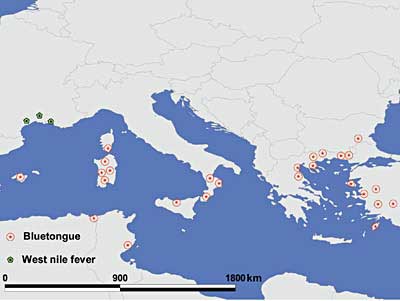This was the first time that bluetongue had been reported from mainland Greece, and in Bulgaria it extended well north of latitude 40oN, which until recently was generally considered to be the northernmost extension of its range in Europe
Recent outbreaks of disease caused by bluetongue virus (BTV) and West Nile virus (WNV) have given cause for concern that their threat might be increasing in the Mediterranean Basin.
Between June and August 1999, reports of bluetongue from the southern border area of Bulgaria signalled the start of an epidemic caused by BTV serotype 9. Reports from Turkey and Greece soon indicated that the epidemic had extended across the borders of the three countries. This was the first time that the disease had been reported from mainland Greece, and in Bulgaria it extended well north of latitude 40oN, which until recently was generally considered to be the northernmost extension of its range in Europe. In Turkey and Greece (extending westwards) outbreaks continued to occur until the end of the year. Outbreaks in the Greek islands close to the Turkish coast, in Lesbos (returning after an absence of 20 years) and the Dodecanese islands (previously affected in 1998) were associated with BTV serotype 4 (and possibly serotype 16 and others), although outbreaks in the Dodecanese islands had last been associated with BTV serotype 9. This raised concern that the virus involved there could have originated from a BTV serotype 4 vaccine used in Western Anatolia, Turkey, in August 1999. Turkey again reported outbreaks in August 2000. Bulgaria and France (Corsica only) resorted to vaccination in March and November 2000 respectively.
Bluetongue and West Nile fever in Europe and North Africa since 1999

Further to the west, a separate epidemic, this time associated with BTV serotype 2, commenced with reports from Tunisia of outbreaks in December 1999 and January 2000, close to the Algerian border. This was the first time the disease had been reported from North Africa. After a lull during the winter, outbreaks started again in June 2000 and were widespread in coastal districts until October. This incidence was matched by outbreaks in contiguous coastal areas of neighbouring Algeria, reported in July and August 2000. From there it appears that infected vectors carried bluetongue to Europe. Outbreaks were reported by Italy (August: Sardinia; November: Calabria and Sicily), France (October: Corsica, for the first time) and Spain (October and November: Balearic Islands, last infected in 1960). Mainland France and Spain remain officially free.
Similarly, WNV (a zoonosis1; vectors Culex and Aedes sp. mosquitoes) has been on the move not only in the United States, which was invaded in August 1999 and where it is now endemically established. Cases in geese were reported from Israel in November 1999 and more than 150 human cases were reported to WHO in 2000. After an absence of more than 30 years, and apparently unrelated to the Israeli incident, WNV returned to France in August 2000, killing horses in the "Camargue" area of Languedoc-Roussillon region in the south. The virus identified in September is similar at the phylogenetic level to viruses isolated in horses in Morocco in 1996, in Italy in 1998 and in mosquitoes in Senegal in 1993.
What has caused these incursions of disease? In the east it is likely that BTV-infected vectors (Culicoides sp. midges) were carried on winds from the Tigris and Euphrates valleys; in the west BTV carriage of vectors across the Sahara from the endemically infected areas of West Africa seems to be implicated. In the case of WNV, migratory birds are a more likely source. Quiescence of such vector-borne diseases is to be expected during the winter period which suppresses vector activity. Whether or not outbreaks will resurge later in 2001 remains to be seen. Is this part of a long-term trend relating to global warming? Only time will tell. Clearly it would be wise to continue epidemiological studies and to strengthen emergency preparedness for vector-borne diseases in this region. Another question that demands attention relates to the desirability of using live virus vaccines produced from strains to be found in distant parts of the world, when serotype designations reflect only expression of one small part of the segmented viral genome and recombination occurs readily.
Sources of data: OIE Disease Information (www.oie.int/eng/info/hebdo/a_info.htm) and
WHO Communicable Disease Surveillance and Response
(www.who.int/disease-outbreak-news/index.html).
1 More information on WNV can be found at the Center for Disease Control Web site: www.cdc.gov/ncidod/dvbid/westnile/